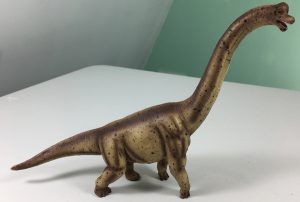Spanish Palaeontologists unearth potential New Species of Brachiosaur
A team of Spanish palaeontologists digging at a site near the remote village of Morella in eastern Spain, have uncovered the remains of what might turn out to a newly discovered dinosaur.
Fossils unearthed to date, indicate a long-necked dinosaur, known as a sauropod. It is not clear which type of sauropod the animal may be, but from the remains found it is probably a representative of the Brachiosauridae, a member of the Macronaria (long-necked dinosaurs with large nostrils, bigger than the orbit of their eyes). The scientists hope they will eventually recover most of the giant animal’s bones, as confirmed in an interview with a palaeontologist leading the excavation.
“It’s a very exciting find, because you rarely come across the bones in their original skeletal shape,” Jose Miguel Gasulla, one of four leaders of the dig in the Valencia region, commented. Indeed, finding a brachiosaur fossil with any of the bones in an articulated or associated position is an extremely rare event.
“We have found vertebrae, ribs and a thigh bone of a very big adult dinosaur from the Early Cretaceous period,” Mr Gasulla added, the dimensions of some of the bones indicate a very large creature. The femur (thigh bone) for example, is 1.80 metres long (as tall as a man) and some of the ribs are 2.40 metres long (higher than a doorway in an average house).
A Typical Brachiosaurus Dinosaur Model
Picture credit: Everything Dinosaur
The picture (above) shows a Mojo Fun brachiosaurus dinosaur model, to view the range of Mojo Fun dinosaurs: Mojo Fun Dinosaurs and Prehsitoric Animal Models.
Spanish Dinosaur
The remains date from the Cretaceous period, approximately 120 million years ago (Aptian faunal stage). Most Brachiosaurus remains are associated with the earlier Jurassic and Cretaceous fossils such as these from Spain may help scientists piece together how the brachiosaurs evolved and changed over time, helping to advance our knowledge about this particular group of dinosaurs.
The 14-strong excavation team have many months of work ahead of them but they are optimistic that these finds could represent a new species of brachiosaur.
Discussing the problems on the dig site, the team have commented that although the fossil bones are large, they are extremely delicate.
Mr Gasulla added: “the vertebrae are big, but fragile, filled with air cavities to make them lighter. If you have a neck six to eight metres long, how do you lift that huge weight? So the bone content was reduced by air holes.”
The region, known as the Maestrazgo, is rich in dinosaur remains, and the site between the towns of Morella and Cinctorres was spotted as promising in 2002. But excavation began only in 2005, when the project obtained funds, initially from a wind energy company, then with the support of Valencia’s regional government.
A New Species?
The naming of a new species of brachiosaur may be more difficult than the team anticipate as a debate is currently raging in palaeontological circles with regards to a number of specimens classified as brachiosaurs dated from the Jurassic. Fossils found in the Morrison Formation when compared to those found in East Africa may indicate different genera. Some palaeontologists have re-classified the African fossils as a new genus of dinosaur called (appropriately enough), Giraffatitan “titan Giraffe”.
To read more about this issue: The debate between Brachiosaurus and Giraffatitan.
Brachiosaurs remain one of the most popular and distinctive of all the dinosaurs, with their long forelimbs and Giraffe-like posture. Brachiosaurus features in our regular dinosaur surveys and is a fixture in the top twenty most popular dinosaurs.
To view a model of a Brachiosaurus and other long-necked dinosaurs: Dinosaur Models and Toys.







Leave A Comment